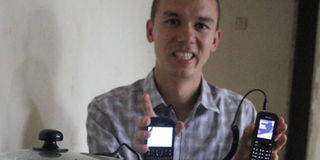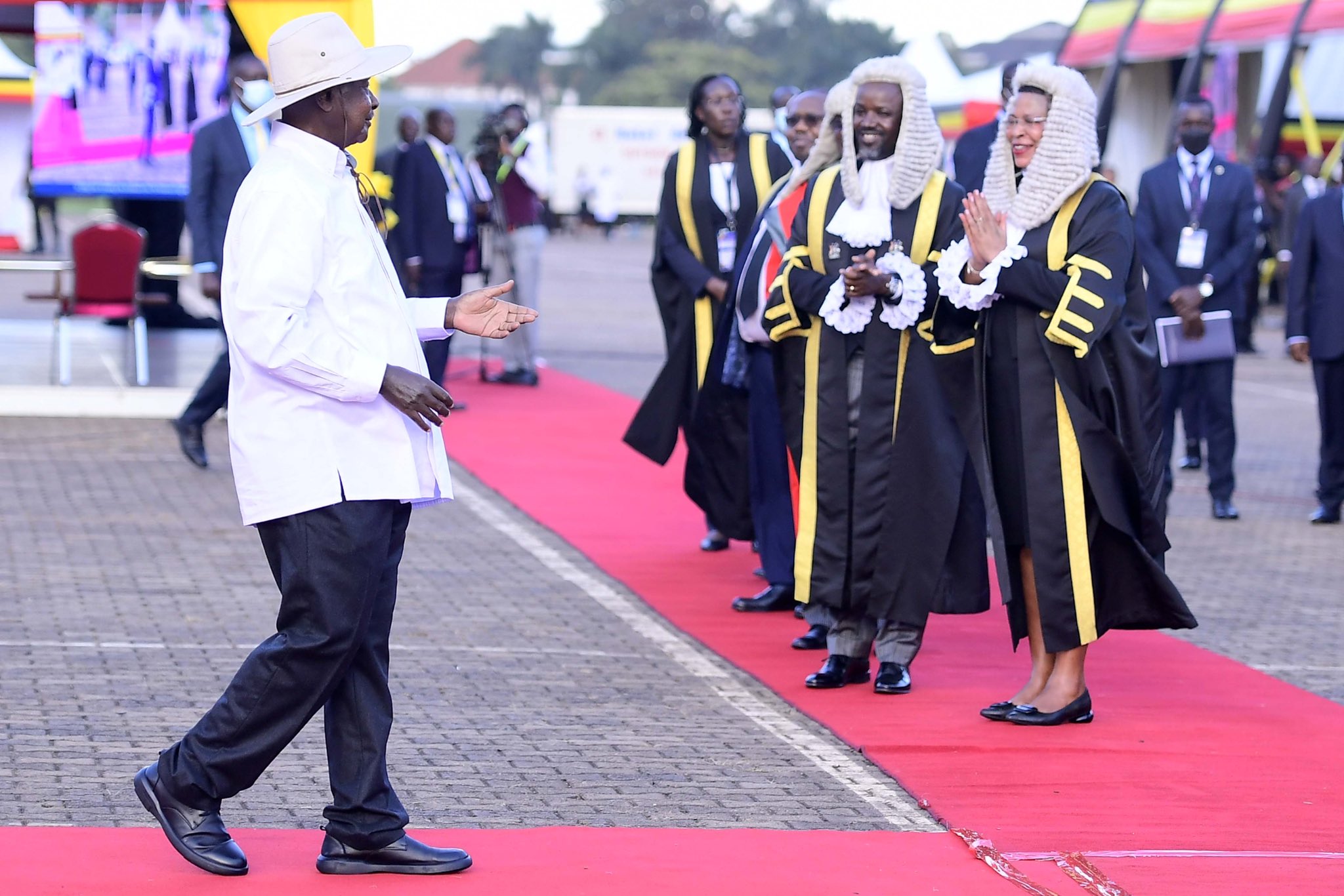The saucepan that cooks while charging phones

Eden Quayle, the CEO of Wonder Pot demonstrates how the retained heat from the cooking pot is converted into energy to charge the phone. This technology ensures that the phone does not burn. PHOTO by Abubaker Lubowa
When someone mentions saucepans, a few ideas come up, a linkage to food and probably the fact that it is a container.
Functions like charging your phone are nowhere on the list and for good reason too.
As far as we have known the saucepan, it has no business charging anything.
But that may soon be history with the invention of the Wonder Pot. Rightly called so, this gleaming stainless steel cooking pot is a dual purpose container that ensures you have a great meal and that your phone is powered up.
How it started
At a demonstration by Eden Quayle, the chief executive officer of Wonder Pot, which is marketing the Japan- made technology, the pot filled with water is placed on a gas cooker and a few seconds after the heat is turned on, the battery icon on a Nokia phone attached at the end of a cable coming from the base of the saucepan starts flickering.
This is an indication that the phone is actually charging.
This particular medium size saucepan charges up to three phones at once. The smaller size pan has an outlet for one phone while a bigger one can charge six phones at once.
“This pot is very new to Africa; Uganda being the first country it has been introduced. It has been on the market in Japan and America mainly as camping equipment,” he says.
Wonder pot is the brainchild of Mr Fujita a thermo technologist and CEO of National Institute of Advanced Industrial Science and Technology in Osaka, Japan.
According to their website, Fujita was motivated by the survivors of the tsunami that hit Fukushima in 2011. With broken powerlines, the victims cooked over open fires and had no way to charge their phones.
Driven by the desire to bring change, it took six weeks to make the pot that could harness the heat from a cooking fire and convert it to electric energy was ready.
The pot was to serve its purpose of helping the tsunami survivors keep in contact with the outside world.
It was made for the overseas market but also serves as a camper’s item.
It is now manufactured under TES New Energy.
Quayle who lived in Uganda between 2007 and 2008 doing charity work in Kisoro was part of the charities that responded to the tsunami aftermath.
The time spent in Uganda had exposed him to the hardships of rural areas. He was particularly drawn to functions that required electricity.
After his relief efforts, he started looking for a startup business preferably one that would help people too. “I saw the wonder pot online and it was perfect,” says Quayle. He adds, “Mr Fujita was not sure how the wonder pot would be useful to Africa.
I explained to him the situation in the villages where people have mobile phones with no way to charge them.
That some had to walk about an hour to the nearest place with electricity to charge phones.”
Specifications
The wonder pot being tested on the Ugandan market by Quayle’s Micro Power comes in a variety of sizes all bigger than the original, the small, medium and big one.
It has two handles on either side as opposed to the original with one. It also has a bigger output directly proportional to size of the pot.
The pot has a thermoelectric module in its base that converts heat into electricity. The current is then transferred through a cable to a phone charging outlet. The energy is created by the temperature difference between the edges of electrical conducive material. The greater the difference between the more electricity,” explains Quayle. The cooking pot can also support LED light as well as charge a car if connected to an inverter, and will produce electricity as long as there is heat.
The more the heat, the more the power generated. The source of heat is not a factor as the pot can be used on charcoal, firewood or gas cookers.
To fully charge a phone, one must cook food items that take a while to get ready which makes the pot ideal. Most local food like beans require boiling. The pot can be a source of income as well.
“We thought to test it as a phone charging business that goes along with the popular tea making business,” says Quayle.
While the pot does not promise to save fuel or energy, it is a good alternative to solar power in off grid areas. The idea is the women were going to cook anyway, now the cooking pot comes in to ensure there is more than one thing accomplished to the same fire.
“It consumes as much as any other saucepan would; it adds no increase or decrease,” he says.
The pot however can be used with an energy saving charcoal stove or other power saving fuels.
The response in target communities has been encouraging.
“I took it to Kisoro and the people were so excited about it, they were amazed and excited.
We tried it at a school and the students were able to read at night. Quayle shares. Dr May Sengendo, the regional chairperson of East African Energy Technology Development Network took a few of the Wonder Pots to Luwero and Ngoma. “People were willing to use the pot and wanted to know how they can get one,” she says.
Therein lies the problems though, getting a wonder pot right now may still be difficult especially for the target market, the people in impoverished off grid rural areas. “It is still very expensive.
The smallest and cheapest is Shs100, 000,” says Sengendo.
Quayle is aware of the affordability issue and says there are plans to make the pot more affordable. “We are looking at the possibility of producing the pot in East Africa,” he says.
Game plan
They are also looking for partner organisations that could help bring this new energy closer to the people.
Dr Sengendo echoes Quayle’s sentiments, She says, “For now Energy Network is testing the pot in parts of Uganda and hopes to expand to the greater region as we look into producing the pot here with readily available materials to make it affordable. “It is the thermoelectric module that may still be expensive.”
Even at the current price, the urban dwelling middle class can invest in their village relatives.
“This is a perfect meeting of circumstances where the middle class want to gift people in the village but power is still a problem with some of these gifts like phones. This pot is a perfect gift to the people in the village,” he says.
The other reaction is about the pot size. “Those we tested it wished it was bigger,” says Sengendo.
Quayle remembers how the Kisoro women wondered what they could cook in the smallet saucepans. Yet even the biggest is too small for the average rural family. Quayle says the feedback will be used to modify the pot to meet market demands.
Breakthrough
Sengendo calls the pot a timely innovation. “It comes at a time when we have been looking at ways to change fire which is present in every rural household into electric energy to make a link in the fire and power,” she says.
As electricity is still a pipe dream in many rural areas and solar power is not that widespread either, the wonder pot fills the void. Quayle says it best, “This pot could revolutionise power generation.”
Output Voltage - 5 Volts
*optional - (12 volts)
Output -30 watts
Number of USB ports - 6 ports
Rapid Charge Port 1 port
Types of Power Supply - USB 2.0/3.0
Width of Pan - 30 cm
All data from TES Co.




